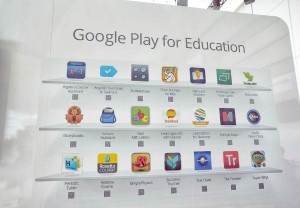
Chromebooks has already grown to be 1/5th of all mobile products bought by schools.
Google often says it is passionate about education and it has taken that drive, and its ability to solve complex engineering problems, to make their Google Play for Education effort a surprisingly fast-growing player in the mobile technology and schools market.
Rick Borovoy, product lead for the effort, said that both teachers and developers have flooded up to him at conferences to thank him for the companies work in this area.
And it is not just anecdotes at presentations. A recent Wall Street Journal piece reported that as of the end of 2013 Google tablets made up 19 percent of the devices being purchased by schools.
This news was followed by an announcement at the end of January that the company would carry thousands of titles from publishers Houghton Mifflin Harcourt, HarperCollins, and Random House.
In short, Google has officially entered the edtech game.
One of the things that has helped Google navigate this effort is an early and important realization, Borovoy said, namely that “the education market is just not the same as the commercial space.”
Some of that realization led to specific engineering projects, like an onerous effort that allowed teachers to use Purchase Orders rather than credit cards to buy apps.
“Credit cards are what teachers use when they don’t want to get reimbursed. So we built purchase orders,” he said.
But beyond the purchasing engine, Borovoy said he and his team traveled to enough schools to understand the customer – the teacher – and their unique position when it came to technology.
“If it becomes slightly cumbersome in a school, it becomes impossible. At Google we’ll all futz with our technology for a few minutes in a meeting to get something to work… We’ll take five minutes to make something work. We all live with it. Teachers won’t live with it,” he said.
Helping the best apps rise to the top
One of the other challenges Google had to address dealt with one of the prime struggles of developers in the learning game space – finadability, the ability to rise to the top in the crowded field of apps claiming to teach a given subject.
Google’s solution was to, as Borovoy said, turn that problem on its head.
For that curated section we pretty much inverted the normal app process. Instead of making it easy to submit and hard to get discovered, let’s make it a little bit harder to submit; let’s make it that you really have to be above an educational bar and then we will make easier to be discovered.
Rick Borovoy, Product Manager at Google
In fact, Google Play for Education’s process for submitting a game into the store takes several steps before it can appear as one of the curated aps. Although submitting an app remains a basic process, the app then goes through a vetting process from a group of educators.
The teachers use the app for some time and then decide how effective it is and what classes, grade levels and Common Core standards the app helps address. Apps that rise to that level then get featured prominently in the Google Play for Education store.
“We feel like it has been too hard for innovative developers to get their content into schools and too hard for teachers to find that content and get it to the right students,” he said.
The result is a mix of curated material tied to standards and carrying the stamp of approval of an independent group of teachers and the full array of apps available from Google Play.
“We bet on curated, but we left a way in for teachers to decide for themselves what’s educational,” he said.
Although this promotion structure may sound like music to developers’ ears, the question of monetization remains one to be answered. Apple’s App Store has a long and documented track record of raking in significant money for developers and Google’s Play, whether for Education or not, is far newer to the scene and has not returned the same amount of money.
Will cracking the Purchase Order issue and improving findability lead to money for developers of learning apps? The answer will likely play out more in the coming year or so.
That said, Borovoy did say that certain types of apps were finding real strength in the educational store.
“Schools are passionate about kids as makers, kids as creators of knowledge not just users of knowledge,” he said. “So right from the get-go we set a very ambitious agenda to make sure we had an awesome set of maker-type tools for kids.”
Googling education
To hear Borovoy describe the critical challenges of the Education team is to hear the normal Google response to product development – the education market is an engineering challenge to be fixed.
“We were told mobile technology isn’t transformative unless you have on the order of a device per student. That’s what they wanted, but it wasn’t affordable or practical,” he said, adding that cost and technology barriers made the scale needed for each student to have a device seemed too expensive.
But it wasn’t just the platform that needed work; it was also what went on it.
“We also heard we needed to make sure that they are awesome in terms of what kids can do with them. Make sure they have a world-class set of tools and educational content,” he said. “And those two things came together and we said, ok we have to solve both of those.”
The result has been an increasingly significant bet that they can get into the education market in a significant way.
“This is an ecosystem, platform bet for us,” he said. “Google got to be Google and Android got to be Android by empowering an ecosystem that encouraged innovative content creators and innovative users and bringing them together. This is what we are after in Education.”
